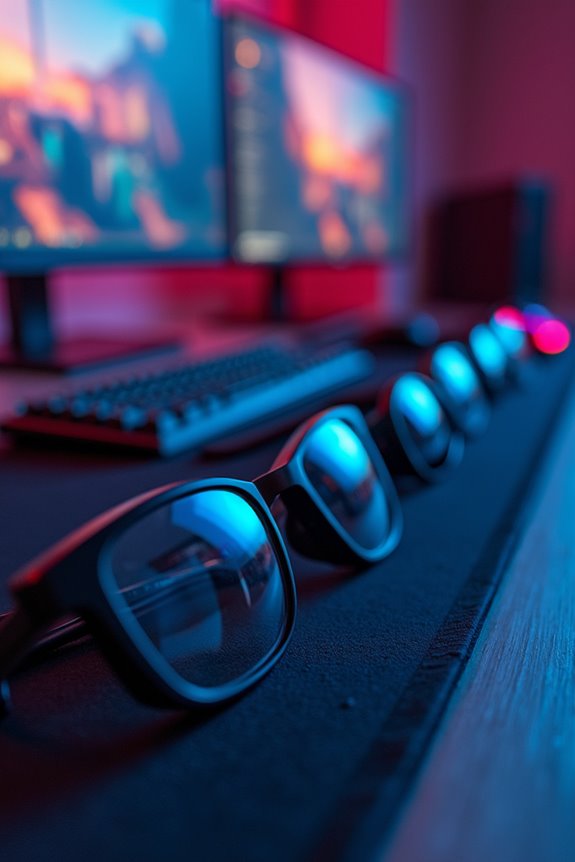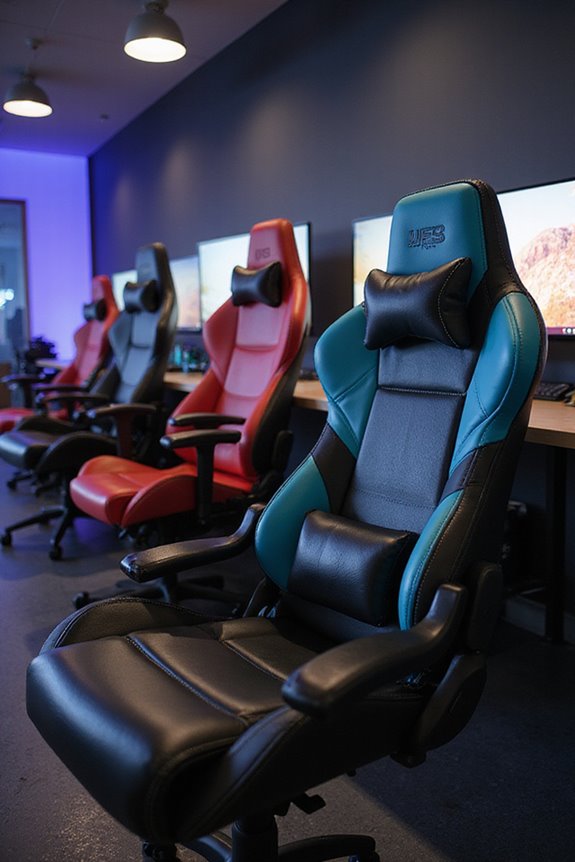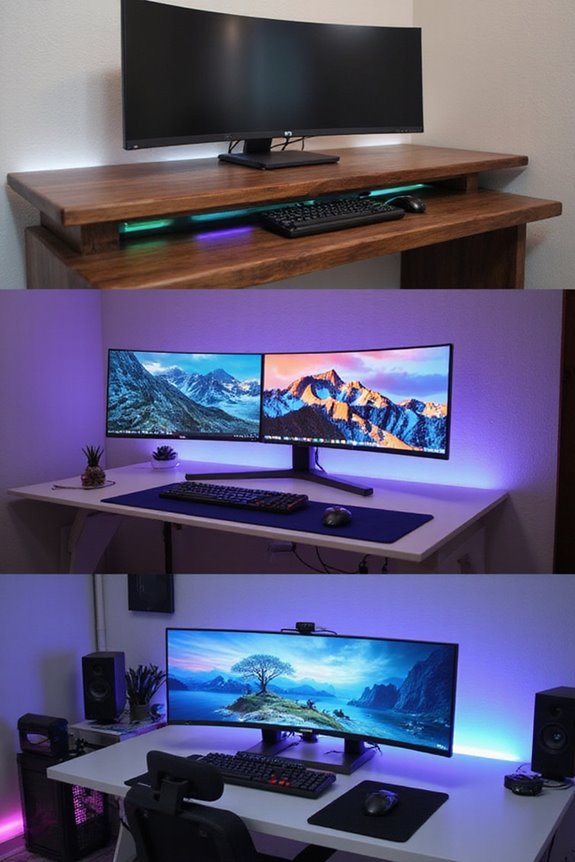As an Amazon Associate, we earn from qualifying purchases. Some links may be affiliate links at no extra cost to you. Although our opinions are based on curated research, we haven't used these products. Articles generated with AI.
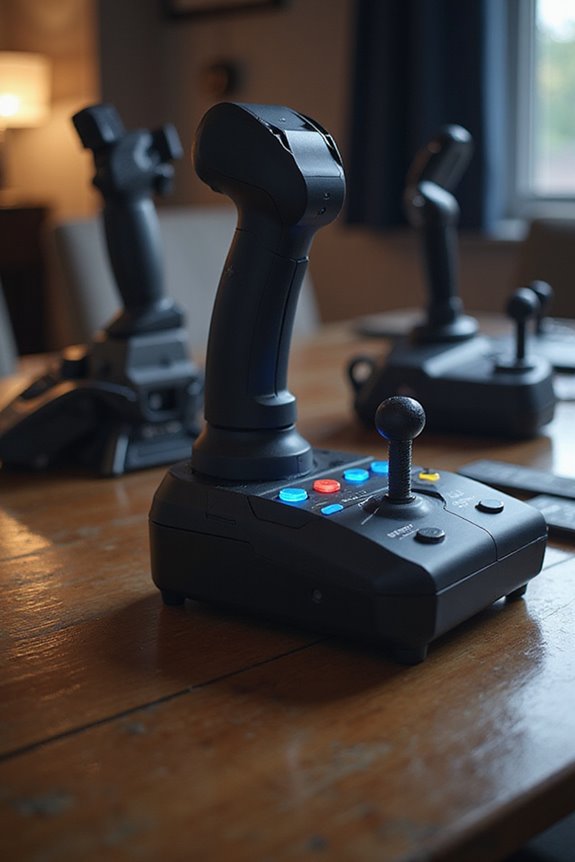
3 Best Flight Simulator Joysticks for an Immersive Flying Experience
For an immersive flying experience, consider the Thrustmaster T-Flight Hotas X, offering 12 programmable buttons and a detachable throttle. The Logitech G X52 Pro boasts magnetic sensors for precision, but its spring tension may cause drift. Meanwhile, the Logitech G X52 shines with a multifunction display, ensuring realism albeit with an initial steep setup. Each joystick promises unique features and quirks. Curious about the details or surprises just around the sky corner?
Key Takeaways
- The Thrustmaster T-Flight Hotas X offers affordability and customization with 12 programmable buttons and adjustable resistance for an immersive experience.
- Logitech G X52 Pro provides precision with magnetic sensors and features an LCD display for enhanced navigation.
- Logitech G X52 boasts a realistic multi-function display and smooth joystick movements, despite its challenging initial setup.
- Consider ergonomics and comfort for long sessions, as well as system compatibility with your flight simulation software.
- Evaluate build quality and user reviews to ensure durability and satisfaction over time.
Thrustmaster T-Flight Hotas X (Compatible with PC)
Thrustmaster T-Flight Hotas X (Compatible with PC)
- Wide hand-rest for optimal comfort.
- Programmable: The 12 buttons and 5 axles are entirely programmable
- Dual-system, aerodynamic control: By rotating handle (with integrated blocking system) or by progressive tilting lever
If you’re diving into the world of flight simulation and seek an affordable yet feature-rich joystick, the Thrustmaster T-Flight Hotas X could be your co-pilot. Released in 2025, it’s a compact powerhouse. Its wide hand-rest guarantees comfort during long flights, and with 12 programmable buttons, you’ll have all the control you need. The detachable throttle is ergonomic, and the joystick’s resistance is adjustable for precision. However, it’s not without its quirks. Some users mention the plastic build feels flimsy, and the joystick can be a bit tight. Despite these, it’s a solid choice for budding virtual pilots.
Best For: Aspiring virtual pilots looking for an affordable yet feature-rich joystick for flight simulation.
Pros:
- Wide hand-rest ensures optimal comfort during extended use.
- 12 programmable buttons and adjustable joystick resistance for customized control.
- Detachable throttle is ergonomically designed for realistic simulation experience.
Cons:
- Plastic build may feel flimsy and lack durability.
- Joystick can be overly tight, affecting ease of movement.
- Missing accessories like rubber grips and Allen wrench for assembly.
Logitech G X52 Pro USB Flight Control System for Simulators
Sale
Logitech G X52 Pro USB Flight Control System - HOTAS Joystick and Throttle for Flight Simulators -...
- Magnetic non-contact X and Y axis sensors provide enhanced longevity and improved accuracy. A dual spring centering mechanism provides a progressive, smooth movement that...
- Multifunction LCD Display affords even greater control of your navigation within Flight Simulator X, thanks to direct control of the simulation’s radio panel...
- 3D Twist with Rudder Lock, essential for simulation control. For those that already have rudder pedals, you can lock off the axis in order to prevent accidental...
The Logitech G X52 Pro USB Flight Control System is perfect for aspiring pilots and casual flight sim enthusiasts looking for a reliable HOTAS setup without breaking the bank. You’ll appreciate its magnetic non-contact X and Y axis sensors, offering long-lasting precision. The multifunction LCD display aids navigation, while the 3D twist rudder with lock provides smooth control.
Users praise the ergonomic 5-position grip system and 282 programmable commands across three modes. However, some find the joystick’s spring tension weak, causing drift. Despite mixed build quality reviews, it’s a solid starter option that won’t empty your wallet.
Best For: Aspiring pilots and casual flight sim enthusiasts seeking an affordable and reliable HOTAS setup.
Pros:
- Magnetic non-contact X and Y axis sensors for precise and durable control.
- Multifunction LCD display aids in navigation and enhances user experience.
- Ergonomic 5-position grip system caters to various hand sizes for comfort.
Cons:
- Weak spring tension in the joystick can lead to drift issues during use.
- Mixed reviews on build quality with some reports of functionality issues.
- Limited customization options for keybinds and initial software compatibility issues.
Logitech G X52 Flight Control System – Standard Packaging
Logitech G X52 Flight Control System - Standard Packaging
- Advanced multi-function display (mfd) for real flying interaction. 2 dedicated mfd buttons and 2 rotary dials with in-built buttons to control additional game...
- Joystick with precision centering mechanism, non-contact technology on x and Y axes and constant spring force
- Progressive throttle with tension adjustment, detents for Afterburner and Idle; 2 Fire buttons
Logitech’s G X52 Flight Control System is perfect for flight simulation enthusiasts who crave a realistic experience. With its advanced multi-function display (MFD), you’ll feel like you’re in a real cockpit. The joystick, featuring non-contact technology, guarantees smooth movements with constant spring force. You can customize your experience with progressive throttle tension, and the illuminated buttons make it ideal for flying at night.
However, setup can be a bit tricky, and the USB cable might feel short. But, with compatibility across major simulators and games, the X52 is a solid choice. Fly high, pilot!
Best For: Flight simulation enthusiasts who desire a realistic and immersive piloting experience.
Pros:
- Advanced multi-function display (MFD) for a realistic cockpit feel.
- Non-contact technology ensures smooth joystick movements.
- Compatible with a wide range of simulation software and games.
Cons:
- Setup process can be challenging for some users.
- USB cable may be too short for certain setups.
- Some users may find button mapping unintuitive initially.
Factors to Consider When Choosing a Flight Simulator Joystick
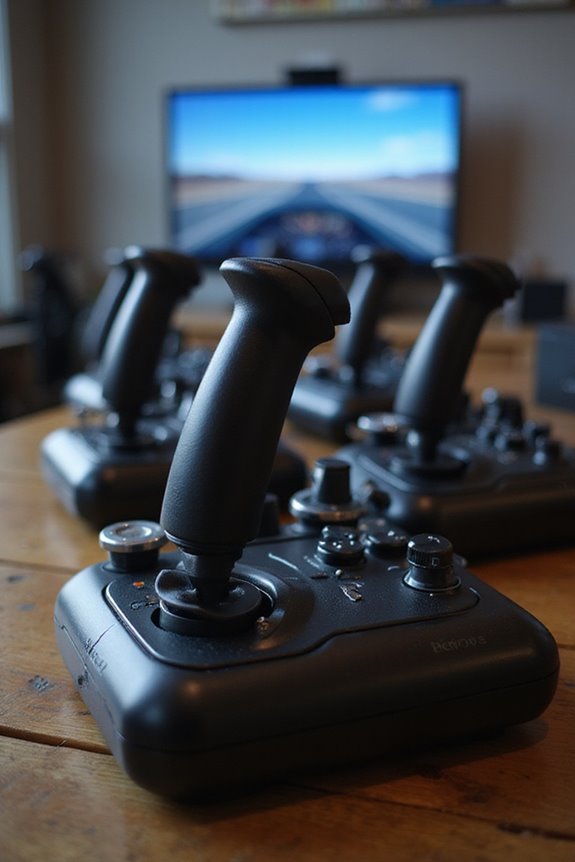
When picking a flight simulator joystick, you’ll want to evaluate factors like ergonomics and comfort, as these will keep your hands happy during long flights. Look into programmability and customization options, which let you tailor controls to your flying style, while precision and accuracy are essential for those tight maneuvers. Don’t forget build quality and system compatibility, ensuring the joystick is sturdy and works seamlessly with your setup, so you can focus on the skies instead of technical issues.
Ergonomics and Comfort
Maneuvering the skies in a flight simulator is not just about the thrill; it’s about comfort and control too. Ergonomics play an important role in joystick design. You’ll want wide hand-rests and adjustable throttle designs for extended use. A joystick that fits various hand sizes, with adjustable grips, guarantees a natural hand position, reducing fatigue. It’s like finding that perfect pair of gloves.
Balancing resistance and ease of movement is vital for precise control. Illuminated buttons and multifunction displays enhance visibility in low-light conditions, keeping you focused. High-quality materials, like rubber grips, offer better tactile feedback and secure handling. Remember, a well-designed joystick doesn’t just fit your hand; it becomes an extension of it, making your virtual flights truly immersive.
Programmability and Customization
A multitude of options in programmability and customization can transform your flight simulator experience into something extraordinary. When choosing a joystick, look for models offering a plethora of programmable buttons—some boast up to 12, alongside multiple axes for extensive customization. This isn’t just for show; it allows for a more tailored flying experience. Internal memory is a handy feature, keeping your settings secure even when unplugged, ensuring you don’t lose your finely-tuned configurations.
Software compatibility is vital too. Many joysticks come with dedicated software that makes mapping profiles and keybinds a breeze. Be sure to assess the number of modes for command switching, as some can handle over 280 commands. An intuitive button layout can greatly improve your programming efficiency.
Precision and Accuracy
Maneuvering the skies in a flight simulator demands more than just customization; it calls for precision and accuracy to truly soar. Precision often hinges on sensor technology. Opt for non-contact sensors—they provide longevity and impeccable accuracy. Don’t forget about adjustable resistance; it lets you tweak the joystick’s feel, enhancing control and comfort. And hey, a smooth centering mechanism? It’s a must for stable and precise shifts.
Programmable buttons and axes are your trusty sidekicks. They tailor controls to your flight scenarios, boosting precision. The joystick’s build quality plays a pivotal role, influencing accuracy and responsiveness. While materials and design specifics explore the next topic, remember, your joystick’s precision is a game-changer for those seamless turns and dives.
Build Quality Considerations
When you’re in the cockpit of a virtual aircraft, the build quality of your flight simulator joystick can make or break the experience. Durability is key; you don’t want buttons sticking or failing mid-flight. Heavier joysticks often offer better stability, providing a solid feel that adds to the immersive experience, while lighter models might feel less premium.
Sturdiness and user satisfaction often go hand in hand, so opt for a joystick with robust throttle components. Effective cable management is another plus, minimizing clutter and preventing those annoying accidental disconnections. Some joysticks feature adjustable tension, allowing you to customize resistance for comfort—perfect for those long-haul flights. So, choose wisely and enjoy those smooth skies!
Compatibility With Systems
Choosing the right flight simulator joystick involves more than just picking a sleek design; you need to verify it plays well with your system. Make sure it’s compatible with your operating system—most joysticks support Windows versions like 7 through 11. USB interfaces are your friend for hassle-free PC connections. Check if the joystick works with major flight simulators, especially if you’re into Microsoft Flight Simulator or DCS World. Programmable features can be a game-changer, but they might require software installation, so confirm it’s compatible. Don’t fly blind; read user feedback for any software hiccups, especially on newer systems. Remember, a joystick that doesn’t mesh with your setup is like a parachute with holes—nobody wants that!
Price and Value
While the allure of a sleek joystick might capture your attention, it’s essential to balance aesthetics with value and price when making your choice. Entry-level options start around $200, while top-tier models can hit $400 or more. It’s vital to evaluate whether the features, like programmable buttons and controls, justify the cost. Consider customer feedback on durability; cheaper models might not last as long. Also, think about the potential need for additional software or accessories, which can add to the total expense.
Don’t forget to factor in future upgrades. A more versatile joystick might have a higher price tag initially, but it could offer better long-term value. So, while you might want to go all out, make sure it’s worth every penny.
Control Systems Variety
Exploring the variety of control systems in flight simulator joysticks can be as thrilling as the simulated flights themselves. You’ll find joysticks with dual-system aerodynamic control mechanisms like rotating handles or progressive tilting levers, enhancing realism. High-precision models often feature adjustable resistance, letting you tailor handling to fit various flight scenarios.
Some joysticks boast multiple programmable buttons, with models offering up to 282 commands, perfect for executing complex maneuvers. Additional features like twist rudders, throttle control levers, and ergonomic grips enhance comfort, especially during long sessions.
Moreover, internal technology varies, with magnetic non-contact sensors providing longevity and accuracy. Whether you prioritize realism or comfort, understanding these features helps you choose a joystick that aligns with your flying aspirations.
User Experience Issues
As you explore the variety of control systems, it’s important to remember that user experience can make or break your flight simulation sessions. Joystick functionality issues, like buttons that stick or fail, can disrupt your virtual flights. Some systems grapple with software compatibility, especially with new operating systems, necessitating clever workarounds for smooth operation.
Build quality is often a concern, with hardware sometimes needing repairs or tweaks, which raises questions about durability. Joystick resistance is essential too; weak spring tension can lead to drift, compromising your flight precision. Button layout and configuration can be a hurdle, as intuitive mapping isn’t always straightforward, and ergonomics might challenge comfort during long flights. Keep these factors in mind for a seamless experience.
Frequently Asked Questions
What Is the Best Joystick for Virtual Reality Flight Simulators?
For virtual reality flight simulators, the Thrustmaster T.16000M shines. Precision-packed and perfect for pilots, it offers a magnetic sensor technology that guarantees accurate controls. You’ll love the ambidextrous design that suits all users. The joystick boasts 16 action buttons, providing extensive command. However, it’s not wireless, so you’ll need to manage cables. For a seamless soar into VR skies, this joystick really elevates your experience—minus the turbulence of complicated setups.
How Do I Calibrate a Flight Simulator Joystick for Optimal Performance?
Calibrating your flight simulator joystick is essential for peak performance. Start by connecting your joystick to your computer, and launch your simulator’s settings menu. You’ll find a calibration option there. Follow the on-screen instructions, which usually involve moving the joystick through its full range of motion. This guarantees accurate input detection. Remember, regular calibration helps maintain precision. If you encounter issues, check for firmware updates. Happy flying!
Are There Joystick Options for Left-Handed Flight Simulator Enthusiasts?
Finding a joystick that suits your dominant hand shouldn’t be a wild goose chase. For left-handed flyers, options like the Thrustmaster T.16000M offer ambidextrous design, providing comfort and precision. It features Hall Effect sensors for accurate input, and 16 action buttons for versatility. While its plastic build might not feel premium, it’s reliable for most virtual flights. Don’t let your left-handedness ground your virtual adventures. Fly high, lefties!
Can I Use Flight Simulator Joysticks for Non-Flight-Related Games?
You can definitely use flight simulator joysticks for non-flight-related games! Joysticks typically feature programmable buttons and precise control axes, making them versatile for various gaming genres like racing or space simulators. However, not all joysticks offer the same compatibility. Before jumping into another game, check if your joystick’s software allows remapping controls. Although they excel in flight sims, you might find them slightly less intuitive for genres without throttle needs.
What Is the Difference Between HOTAS and Regular Flight Simulator Joysticks?
You’re wondering about HOTAS vs. regular joysticks, huh? Well, HOTAS setups, with their separate throttle and stick, offer more control and realism, making you feel like a pilot. Regular joysticks are simpler, just plug and play, but can’t match HOTAS in precision. Think of HOTAS as a full orchestra while regular joysticks are a solo act. Sure, HOTAS is pricier, but for serious sim enthusiasts, it’s worth the investment.




